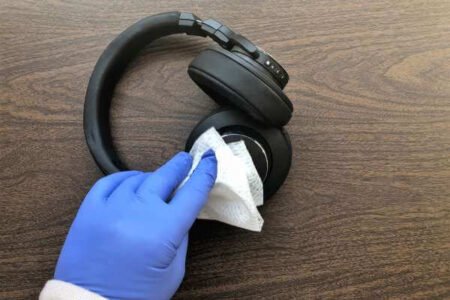In our increasingly interconnected world, headphones have become an integral part of our daily lives, providing a personal auditory experience. While headphones offer a convenient and immersive way to enjoy music, podcasts, and calls, concerns have been raised about their potential connection to ear infections. Many of my friends ask me can headphones cause ear infection. The short answer is yes, here is the long answer of the link between headphones and ear infections, examining the risks and preventive measures.
Can Headphones Cause Ear Infection?

Yes, improper usage of headphones can lead to ear infections.
How Headphones Work: To comprehend the potential link between headphones and ear infections, it’s essential to understand how these devices function. Headphones produce sound waves that travel through the air and enter the ear canal. Depending on headphone type, audio source proximity, and usage duration can impact ear health.
Risk Factors:
- Moisture Accumulation: Prolonged use of over-ear or in-ear headphones can create a warm and moist environment in the ear canal. This moisture, combined with the darkness, can potentially create a breeding ground for bacteria or fungi, increasing the risk of ear infections.
- Bacterial Transfer: Sharing headphones can lead to the transfer of bacteria from one person’s ears to another’s, potentially introducing harmful microorganisms that may cause infections.
- Inadequate Cleaning: Infrequent cleaning of headphones, especially in-ear varieties, can result in the buildup of earwax and dirt, creating an environment conducive to bacterial growth.
Preventive Measures:

- Regular Cleaning: To mitigate the risk of ear infections, it is crucial to clean your headphones regularly. Cleaning with a gentle disinfectant and maintaining in-ear pieces can minimize bacteria buildup.
- Limiting Usage Time: Prolonged use of headphones, especially in-ear varieties, can contribute to moisture retention in the ear canal. Taking breaks and limiting the duration of use can help prevent excessive moisture buildup.
- Personal Use: Avoid sharing headphones, as this can minimize the risk of bacterial transfer from one person to another.
- Choosing the Right Type: Over-ear headphones generally pose a lower risk of moisture retention compared to in-ear headphones. Choosing the type that suits your comfort and hygiene preferences can improve ear health.
Understanding the Adverse Health Effects of Improper Headphone Usage
Improper headphone usage can lead to various health issues, emphasizing the importance of responsible and mindful use of these popular audio devices. Here are some common health concerns associated with inappropriate headphone usage:
1. Hearing Loss
Prolonged exposure to high-volume levels through headphones can contribute to gradual hearing loss over time. Listening to music or other audio content at excessively loud volumes can damage the delicate structures of the inner ear, leading to diminished hearing capabilities.
2. Ear Infections
Inadequate cleaning of headphones, prolonged use, and sharing devices can create a favorable environment for bacteria or fungi to thrive. Moisture retention in the ear canal, coupled with the warmth from extended headphone use, increases the risk of ear infections.
3. Tinnitus (Ringing in the Ears) and Ear Pain
Continuous exposure to loud music or sounds through headphones may result in tinnitus, a condition characterized by persistent ringing or buzzing in the ears. Additionally, users may experience ear pain or discomfort, especially when using headphones for extended periods at high volume levels.
4. Damage to Ear Canal Skin
The constant pressure and friction from headphones, particularly in-ear and on-ear styles, can lead to irritation and damage to the delicate skin of the ear canal. This may result in discomfort, itching, or inflammation.
5. Noise-Induced Hearing Loss (NIHL)
Noise-induced hearing loss occurs when the ears are exposed to excessively loud sounds, causing damage to the hair cells in the inner ear. Headphones that are consistently used at high volumes can contribute to this irreversible form of hearing damage.
6. Impaired Spatial Awareness
Overly immersive or noise-canceling headphones can hinder a person’s awareness of their surroundings. This lack of spatial awareness may lead to an increased risk of accidents, especially when walking, cycling, or engaging in activities that require attention to the environment.
7. Social Isolation
Excessive use of headphones in social settings can contribute to social isolation. Being constantly plugged into personal audio experiences may limit interpersonal communication and connection with others.
Can headphones cause inner ear problems?
Yes, headphones have the potential to cause inner ear problems, especially when used improperly. Prolonged exposure to high volumes can contribute to hearing damage and may lead to issues such as tinnitus or ear pain. Additionally, the use of unclean headphones can create a conducive environment for bacterial growth, increasing the risk of ear infections. It’s essential to use headphones responsibly, maintain proper hygiene, and be mindful of volume levels to minimize the risk of inner ear problems. If individuals experience persistent discomfort or symptoms, seeking professional medical advice is advisable.
Conclusion of Can Headphones Cause Ear Infection

Conclusion: While the use of headphones is generally safe, it’s essential to be mindful of potential risk factors that could contribute to ear infections. By adopting good hygiene practices, such as regular cleaning and limiting usage time, headphone enthusiasts can enjoy their favorite audio experiences while minimizing the likelihood of ear-related complications. As with any health concern, if you experience persistent discomfort or signs of an ear infection, consulting with a healthcare professional is advisable for proper diagnosis and treatment.



